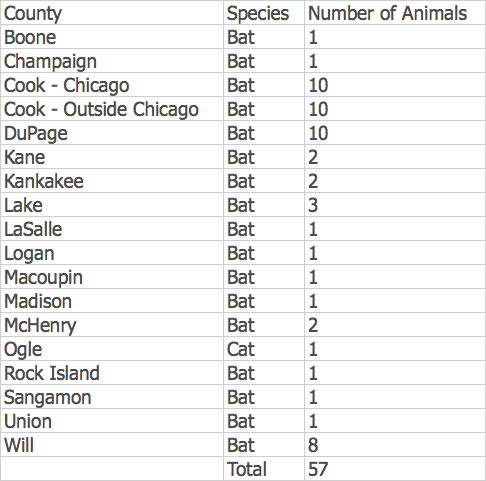By Lakshmi Chandrasekaran
Recent weeks have seen a spike in the number of rabies cases in bats in the Will, Cook and Dupage counties area (see chart below). As bats become more fearless and accustomed to noise, urban areas make good homes. Having bats in communities could be good for eliminating pests and pollinating flowers but these nocturnal creatures are also one of the carriers of the deadly virus rabies.

A rabies surveillance chart of the counties in Illinois shows more than 50 rabid bats in the area tracked since the beginning of this year. A couple of weeks ago, a bat was killed by a pet dog in Will County. The pet’s owners used their hands to remove the bat from the dog’s mouth and, unfortunately, the bat tested positive for rabies. The family was advised to receive a series of shots to prevent infection from the rabies virus.
“Almost 100 percent of all rabies cases reported to the Illinois Department of Health are in bats,” says Melaney Arnold, a public information officer at the Illinois Department of Health.
But fortunately, “less than 1 percent of the bats from the total population are affected by rabies,” comments Dr. Michele Roessler, the deputy administrator at the Will County Animal Control Department. However, this is an estimate, since there is no data available on the bat population in all the counties. Neither Lincoln Park Zoo nor Brookfield Zoo had data.
According to Dr. Steve Taylor of the Illinois Natural History Survey, a survey is underway to document bat activity and populations across Illinois. Following bats with a census may be a key step to prepare for these challenges.
Does this mean we should be scared of rabid bats attacking us? Not at all, reassures Roessler. Illinois law requires pet dogs and cats to be vaccinated for rabies. “That is why we do not see rabies occurring in cats, dogs and other domesticated species,” she says.
Out of an abundance of caution, the Will County animal control follows up over extended periods of time on pets exposed to rabid bats, according to Dr. Roessler. These pets are also confined to their property during this observation period, to limit contact with other people. The owners of these pets are advised to be cautious and limit their activities with them. The county health department oversees any treatment required by the owners such as taking a post-exposure rabies vaccination.
Besides carrying rabies, bats are one of the carriers of the Ebola virus. Although the Ebola epidemic is largely contained now, nevertheless, non-threatening forms of viruses can remain in bats, with the potential to infect humans. This is the problem that we cannot avoid, with co-existence of different animals.
But a key question is why are there more bats in an urban environment.
A recent study by an international group of researchers demonstrates how bats can adapt to increased background noise by changing their foraging methods. The bats used in this study are a neo-tropical species known to quietly eavesdrop on calls made by frogs – to prey on them.
To conduct their study, the researchers captured 12 bats from Soberania National Park in Panama. The scientists then mimicked the bat-foraging situation in the lab by using a couple of ‘robotic’ frog models and followed which of the two frogs the bats attacked. But what was different about the two robotic frogs?
One of the models only emitted the sound of a frog call with a ‘static’ vocal sac, whereas the second one mirrored the frog vocal sac movement (inflating or deflating) while it makes a mating call. All this was presented to the bats with increasing background noise.
“We tested how high levels of noise affected their attack behavior and found that bats were slower in making an attack,” said Wouter Halfwerk, an assistant professor at the Department of Ecological Science, Vrije Universiteit, Amsterdam. This noise pollution is detrimental to bats as they struggle to find their food, said Halfwerk, one of the senior scientists of the study, published in Science.
However, the experiments revealed that, when exposed to the two frog different sounds, under noisy situations, the bats preferred to attack the second frog model. “We know that bats can sense the [frog vocal sac] movement through their echolocation,” says Halfwerk. Echolocation, similar to a sonar system, is a mechanism by which the bat uses echoes and sound waves to locate its food source. Bats are equipped to ‘hear’ their prey move.
Prior to these experiments, the scientists had no idea as to how bats would change their echolocation to adapt to noisy background levels. However, this study demonstrated that bats follow ‘multiple movements’ with echolocation under noise.
These findings are critical as they demonstrate novel and evolving foraging mechanisms displayed by animals living in an environment consistently altered by human technological advancements, the scientists concluded.
“Since it is probably true that not all animals are capable of switching to alternative foraging strategies in the presence of masking noise, the increasing noisy environment might impact different species deferentially, ” warns Jinhong Luo, an independent expert in the field, at the Johns Hopkins University, who is not a part of this study. However, what is unknown are the kinds of consequences in our ecological system that this could cause. “But of course, these predictions or speculations await further evidence,” he adds.


